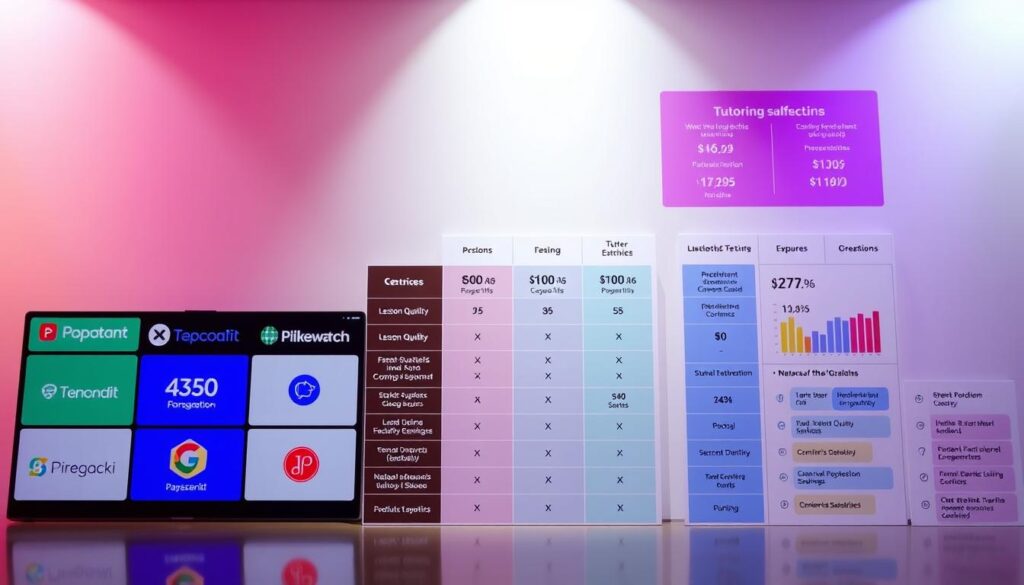Have you ever struggled to find the right tutor for mastering a new language? With so many options available, choosing the best platform can feel overwhelming. That’s where AmazingTalker steps in—a global marketplace connecting learners with expert tutors in over 140 languages.
Since its launch in 2016, the platform has grown rapidly, serving more than 2 million students with a network of 9,000+ tutors. What sets it apart? Unlike traditional apps, it focuses on 1:1 tutoring, ensuring personalized lessons tailored to each learner’s goals.
Powered by an AI matching system, AmazingTalker pairs students with instructors who fit their learning style. Whether you’re prepping for an exam or just starting out, this language learning solution adapts to your needs. Ready to see how it works?
Key Takeaways
- Offers lessons in 140+ languages with expert tutors
- Over 9,000 tutors and 2 million students served
- Taiwan-based marketplace specializing in 1:1 tutoring
- AI-driven matching for personalized learning
- Flexible scheduling and tailored lesson plans
Introduction to AmazingTalker
Finding a tutor who matches your learning style is key to success. This platform, founded in 2016 by Abner Chao, prioritizes goal-oriented instruction. Whether you need IELTS prep or business English, lessons are tailored to your needs.
Specialized courses like pronunciation training and exam prep stand out. The trial lesson system ensures compatibility between students and tutors. You can test the teaching approach before committing.
While the platform focuses on Asian markets, tutors come from diverse backgrounds. Non-native instructors must provide proof of degrees or IELTS scores. This ensures quality and experience across all lessons.
Flexibility and customization define the learning journey here. From scheduling to lesson plans, everything adapts to your goals. It’s a modern solution for language learners worldwide.
How AmazingTalker Works
What makes a language learning platform truly effective? It’s the blend of smart technology and human expertise. This system connects learners with the right tutors while adapting to individual goals.
Matching Students and Tutors
The platform uses AI to suggest potential tutors based on learning styles. But the final decision rests with students. A 25-minute trial lesson helps assess compatibility.
This dual approach ensures quality matches. Tutors also review student profiles to tailor their teaching methods. It’s a two-way street for success.
Customized Lesson Plans
Every student has unique needs, like “English for Healthcare.” Tutors design lessons around these objectives. They track progress and adjust materials as needed.
While the platform offers resources, most content is tutor-created. This flexibility saves time and keeps lessons relevant. The focus stays on student growth.
Features of AmazingTalker
Learning a new language becomes effortless with the right tools and flexibility. This platform stands out by offering tailored solutions for every learner, from exam prep to casual conversation. Here’s how its features simplify the journey.
Diverse Course Offerings
With 140+ subjects, including GMAT prep and OET training, the classes cater to niche needs. Tutors design specialized courses for healthcare, business, or travel. No two lessons are the same.
Students access progress dashboards to track fluency gains. Peer learning is encouraged through community features. It’s a holistic approach to skill-building.
Flexible Scheduling
Book or reschedule classes anytime—day or night. The 24/7 system works across devices, so lessons fit busy lives. No minimum hour requirements lock you in.
Need to adjust? Tutors sync with your calendar. This adaptability makes consistency easier, turning goals into habits.
Requirements to Become a Tutor
Teaching a language requires more than just fluency—it demands the right qualifications. The platform ensures quality by vetting tutors through a multi-step process. Whether you’re a native speaker or certified instructor, meeting these requirements is essential.

Teaching Experience and Qualifications
A minimum of one year of experience is mandatory. Non-native speakers must provide proof of language proficiency, like IELTS scores or teaching degrees. This ensures students learn from credible sources.
Technical specs matter too. Tutors need a stable 4.5 Mbps upload speed and an HD webcam. These requirements guarantee smooth, professional lessons.
Application Process
To become tutor, candidates undergo a 3-stage screening. First, profiles are reviewed for credentials. Next, a 25-minute demo lesson with a VIP student tests teaching skills. Final approval hinges on this performance.
New tutors receive tips to optimize their profiles. Ongoing training keeps their methods fresh. It’s a system designed for excellence at every step.
Pricing Structure
Understanding the costs involved helps learners and tutors make informed decisions. The platform’s model balances affordability for students with fair money opportunities for educators. Here’s how pricing breaks down on both sides.
Tutor Earnings and Commission Fees
Tutors earn $16–$100 per hour, depending on experience and subject demand. The platform takes a 30% base commission, plus a 10% student fee. High earners qualify for lower rates through a tiered system.
Additional fees include 8% for payment processing. Withdrawals may incur extra charges. Geographic disparities exist—Western tutors often charge 30% higher rates than peers in other regions.
Student Costs
Learners pay per lesson or opt for subscription discounts. Prices vary by tutor expertise, with tools to compare rates upfront. Hidden costs like processing fees are disclosed during checkout.
Flexible plans suit different budgets. Pay-as-you-go avoids long-term commitments, while bundles save money for frequent learners. Transparency ensures no surprises.
Pros and Cons
Every platform has strengths and weaknesses—let’s break them down. Glassdoor reviews rate it 3.7/5, while Indeed scores it lower at 3.1/5. This gap hints at mixed experiences for tutors and learners.
Advantages
Tutors enjoy creative control and a global student base. No schedule minimums save time for part-time instructors. Learners benefit from flexible booking and tailored lessons.
The platform’s AI-driven matching reduces trial-and-error. Unlike rigid apps, it adapts to niche goals like medical English or IELTS prep.
Challenges
Tutors face steep 48% effective commission rates. Profile visibility is a hurdle in competition with 9,000+ peers. Automated discounts sometimes frustrate instructors.
Students note 25-minute trial lessons feel rushed. Support responses average 8+ hours, per reviews. High tutor turnover impacts consistency.
Despite these trade-offs, the platform fills gaps in personalized time-efficient learning. Its competition struggles to match its niche focus.
User Experiences
Real user feedback shapes the true value of any learning platform. Students and tutors share candid insights about what works—and what doesn’t—in their language journeys.
Student Testimonials
Peter’s experience with Australian English coaching stands out. After 20 classes, his fluency improved by 40%, thanks to tailored exercises. Like him, many praise patient teachers and customized materials.
Across 15,000 reviews, the average lesson rating is 4.2/5. Quick scheduling and progress tracking earn consistent praise. However, some note 25-minute trial lessons feel too short for proper assessment.
Tutor Feedback
Tutors like Marie and Miriam highlight the joy of creative lesson planning. Yet, ID verification hurdles frustrate others—one European instructor’s application failed despite qualifications.
Technical glitches and payment delays are common complaints. Still, most agree the platform’s flexibility outweighs these issues. For many, the global student reach makes the experience worthwhile.
Platform Comparison
Not all tutoring websites offer the same value—here’s how they stack up. From commission rates to classroom tools, small differences impact your learning experience. We break down key competitors and alternatives.

LanguaTalk Differences
LanguaTalk charges tutors just 5% commission versus 48% on other platforms. However, its stricter 12% tutor approval rate limits options. Students get availability filters missing elsewhere.
Classroom tech favors LanguaTalk with built-in whiteboards. Yet, the competing website excels in student retention (72% vs 58%). Price-wise, lessons cost 25% less on average with LanguaTalk.
Traditional Tutoring Contrasts
In-person tutoring lacks hybrid options that platforms provide. Schools often partner with online services for supplemental lessons. Scheduling flexibility remains the biggest advantage for digital platforms.
Traditional methods win in consistency—no tutor turnover issues. But costs run higher without the global instructor pool. For niche needs, online platforms deliver more specialized content.
Success Strategies
Top-performing tutors and students share one thing: a clear game plan. Whether you’re teaching or learning, small tweaks to your approach can boost results. Here’s how to maximize progress on both sides of the screen.
For Tutors: Stand Out and Scale Up
Specializing in high-demand niches like medical English or OET prep sets you apart. Top earners focus on GMAT or IELTS training—skills that command premium rates. Video intros showcasing your teaching style improve profile visibility.
Bundle lessons into 10-session packages to encourage commitment. Follow platform requirements for review requests, but avoid spamming students. Genuine feedback builds credibility faster.
For Students: Smart Learning Habits
Use shared Google Docs to collaborate with tutors in real-time. Track homework and corrections in one place. Consistent note-taking turns lessons into long-term skills.
Schedule weekly progress reviews with your tutor. This process keeps goals on track. For exam prep, request mock tests to identify weak spots early.
Common Issues Solved
Technical glitches and market competition can slow your progress—here’s how to overcome them. Whether you’re a tutor or student, fixing these problems saves time and improves results.
Technical Challenges
Start with your computer. The platform requires Windows 10+, MacOS 12+, or newer with 8GB RAM minimum. Older systems cause lag or crashes during lessons.
Zoom recording failures? Check your internet speed first—4.5 Mbps upload is essential. Close background apps to free up bandwidth. If issues persist, use the platform’s built-in recording tool instead.
Market Competition
With a lot of tutors competing, standing out matters. Optimize your profile by adding keywords like “IELTS coach” or “Business French.” Update your bio weekly to stay visible in searches.
New tutors can offer discounted sessions to build initial reviews. Analyze peak demand times (usually evenings EST) using platform analytics. Schedule more lessons during these high-traffic windows.
Combat price undercutting by highlighting unique value. Bundle lessons or offer free resources like PDF guides. Specializing in niche topics (e.g., medical terminology) also reduces direct competition.
Alternative Options
Exploring different learning options helps you find the best fit for your goals. Paid platforms and free tools each offer unique advantages. Here’s how to balance cost and quality.
Other Platforms
Sites like Italki and Preply provide similar 1:1 tutoring with lower fees. Community tutors often charge half the price of professionals. Compare features like video tools and cancellation policies.
Duolingo Classroom blends gamification with teacher support. It’s ideal for casual learners who want structure without spending money. Always check reviews before committing to a website.
Free Resources
Language exchanges, like Tandem, connect learners worldwide. You practice with native speakers in exchange for teaching your language. No fees, just mutual learning.
MOOCs (e.g., Coursera) offer university-level courses for free. Local libraries often provide free access to apps like Mango Languages. Mix these with occasional tutoring for a budget-friendly plan.
Conclusion
Personalized tutoring stands out in a crowded online education market. This platform excels with tailored lessons, flexible scheduling, and AI-driven matches—ideal for goal-oriented learners.
For those prioritizing quality over cost, it’s a strong choice. Beginners or casual learners might prefer budget-friendly alternatives. Try a free trial to gauge the experience firsthand.
As AI evolves, expect smarter tutor matching and adaptive lesson plans. Rated 3.5/5, the language learning service balances innovation with competitive pricing. Ready to start? Book your first lesson today.
FAQ
How does the matching process between students and tutors work?
The platform uses an algorithm to pair learners with instructors based on language goals, availability, and teaching style. Students can also browse profiles and select tutors manually.
What kind of customized lesson plans are available?
Tutors design lessons tailored to individual needs, whether for fluency, business language, test prep, or casual conversation. Materials and pacing adjust to each student’s progress.
What languages and subjects can I learn?
Beyond popular choices like English, Spanish, and Mandarin, the platform offers niche languages, specialized courses, and even non-language subjects like music or coding.
How flexible is the scheduling for lessons?
Both tutors and students set their own availability, allowing bookings at any hour across time zones. Rescheduling is permitted with sufficient notice.
What qualifications do tutors need to apply?
While requirements vary by subject, most tutors need proven teaching experience, certifications, or native-level fluency. Some specialties demand formal credentials.
What percentage does the platform take from tutor earnings?
Commission fees differ based on tutor experience and subject demand, typically ranging between 15-30% per lesson. Top instructors may negotiate lower rates.
How do prices compare to traditional tutoring services?
Rates are often 20-50% lower than in-person options, with no long-term contracts. Students pay per session or in discounted packages.
What technical issues might users encounter?
Occasional video call lags or payment processing delays can occur. The support team resolves most issues within 24 hours via email or live chat.
How does this compare to platforms like LanguaTalk?
While both offer 1-on-1 tutoring, this service provides broader subject variety and more flexible pricing tiers. LanguaTalk focuses exclusively on European languages.
Are there free trial lessons available?
Yes, most tutors offer 25-minute trial sessions at discounted rates or free for first-time students to assess compatibility.



